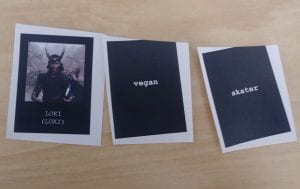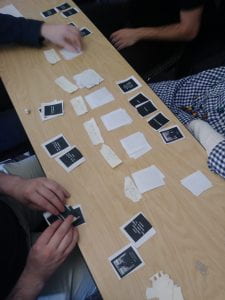My intervention project was inspired heavily by guerilla street projections featured in the tactical media documentary screened in class. The scale and inherent impermanence/non-criminalizing aspect of the intervention specifically appealed to me. I didn’t feel comfortable or safe involving my body in an intervention so the relative anonymity was also attractive.
Recently I’ve been very focused on bringing attention to the realities of transmasculine discrimination and oppression. I’m very frustrated by the fact that little people seem to understand our experiences or acknowledge our specific oppression. Throwing up a huge projection about those experiences for all to see felt like a good way to channel that frustration.
I wanted to use text that could be easily read and digested, so I took statistics from the 2015 and 2011 Trans Equality Reports, as well as some general truths and imperatives pertaining to transmasculine people. They are as followed:
I planned to laser cut the text and place it on a LED light box to project, so I created the designs in Adobe Illustrator with a laser cut-friendly font. I didn’t realize that the resulting image would not be magnified or projected strongly enough to be seen on a building (or at all, really). After running into that roadblock, I decided to utilize a projector, and edited my designs accordingly. I filled in the text and converted them into a PDF that I could blow up on my screen and click through.
I had trouble finding a room in Northeastern that was open at night and also had a big window that could be fully opened. I ended up testing the intervention in Kariotis. Only the top half of the window in the classroom opened, and it was not feasible to point the projector out of it. The projector could not project the image through window glass, either. I improvised by projecting the text across the room from the window, so it was clearly visible to anyone outside the window.
At home in Mission Hill, I attempted my initial idea. It worked to an extent, but because of the window screen on my window, the image was dimmed considerably.
I didn’t get any candid interaction (that I noticed) with the projections because it was late on finals week/late in Mission Hill.
At one point, while going outside to take photos, I found myself locked out of the building, and while that was really frustrating because all of my things were inside, it made me think about the prospect of having the projection as a running installation this way.
If I was to do the intervention again, I would secure a room for a day (or a night, depending on whether the projection is sufficiently visible at day), possibly locking it from the inside, and set up the projector and laptop. I would edit the designs into a looping GIF that clicked through each of the designs at a readable pace. I might choose a higher traffic area if I could one with a window with such high visibility from the ground.
I’m very happy with what I’ve made and would love to run it again. I think with the proper circumstances and resources I could do similar in scale to the tactical media projections with my designs!


